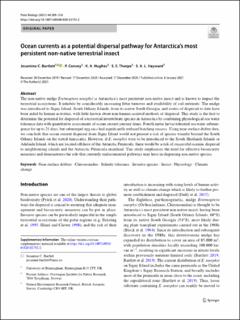| dc.contributor.author | Bartlett, Jesamine | |
| dc.contributor.author | Convey, Peter | |
| dc.contributor.author | Hughes, K.A. | |
| dc.contributor.author | Thorpe, S.E. | |
| dc.contributor.author | Hayward, S.A.L. | |
| dc.coverage.spatial | Signy Island, South Orkney Islands, South Georgia, Antarctica | en_US |
| dc.date.accessioned | 2022-12-20T13:45:51Z | |
| dc.date.available | 2022-12-20T13:45:51Z | |
| dc.date.created | 2021-04-19T12:59:41Z | |
| dc.date.issued | 2021 | |
| dc.identifier.citation | Polar Biology. 2021, 44 (1), 209-216. | en_US |
| dc.identifier.issn | 0722-4060 | |
| dc.identifier.uri | https://hdl.handle.net/11250/3038879 | |
| dc.description.abstract | The non-native midge Eretmoptera murphyi is Antarctica’s most persistent non-native insect and is known to impact the terrestrial ecosystems. It inhabits by considerably increasing litter turnover and availability of soil nutrients. The midge was introduced to Signy Island, South Orkney Islands, from its native South Georgia, and routes of dispersal to date have been aided by human activities, with little known about non-human-assisted methods of dispersal. This study is the frst to determine the potential for dispersal of a terrestrial invertebrate species in Antarctica by combining physiological sea water tolerance data with quantitative assessments of ocean current journey times. Fourth instar larvae tolerated sea water submer gence for up to 21 days, but submerged egg sacs had signifcantly reduced hatching success. Using near-surface drifter data, we conclude that ocean current dispersal from Signy Island would not present a risk of species transfer beyond the South Orkney Islands on the tested timescales. However, if E. murphyi were to be introduced to the South Shetlands Islands or Adelaide Island, which are located ofshore of the Antarctic Peninsula, there would be a risk of successful oceanic dispersal to neighbouring islands and the Antarctic Peninsula mainland. This study emphasises the need for efective biosecurity
measures and demonstrates the role that currently undocumented pathways may have in dispersing non-native species. | en_US |
| dc.language.iso | eng | en_US |
| dc.rights | Navngivelse 4.0 Internasjonal | * |
| dc.rights.uri | http://creativecommons.org/licenses/by/4.0/deed.no | * |
| dc.subject | Near-surface drifters | en_US |
| dc.subject | Chironomidae | en_US |
| dc.subject | Salinity tolerance | en_US |
| dc.subject | Invasive species | en_US |
| dc.subject | Insect | en_US |
| dc.subject | Physiology | en_US |
| dc.subject | Climate change | en_US |
| dc.title | Ocean currents as a potential dispersal pathway for Antarctica’s most persistent non-native terrestrial insect | en_US |
| dc.type | Peer reviewed | en_US |
| dc.type | Journal article | en_US |
| dc.description.version | publishedVersion | en_US |
| dc.rights.holder | © 2021 The Authors | en_US |
| dc.subject.nsi | VDP::Zoologiske og botaniske fag: 480 | en_US |
| dc.subject.nsi | VDP::Zoology and botany: 480 | en_US |
| dc.source.pagenumber | 209-216 | en_US |
| dc.source.volume | 44 | en_US |
| dc.source.journal | Polar Biology | en_US |
| dc.source.issue | 1 | en_US |
| dc.identifier.doi | 10.1007/s00300-020-02792-2 | |
| dc.identifier.cristin | 1905070 | |
| dc.relation.project | Andre: d British Antarctic Survey (Grant No. CASS121) | en_US |
| dc.relation.project | Andre: Natural Environment Research Council (Grant No. RRBN19276 | en_US |
| cristin.ispublished | true | |
| cristin.fulltext | original | |
| cristin.qualitycode | 1 | |

